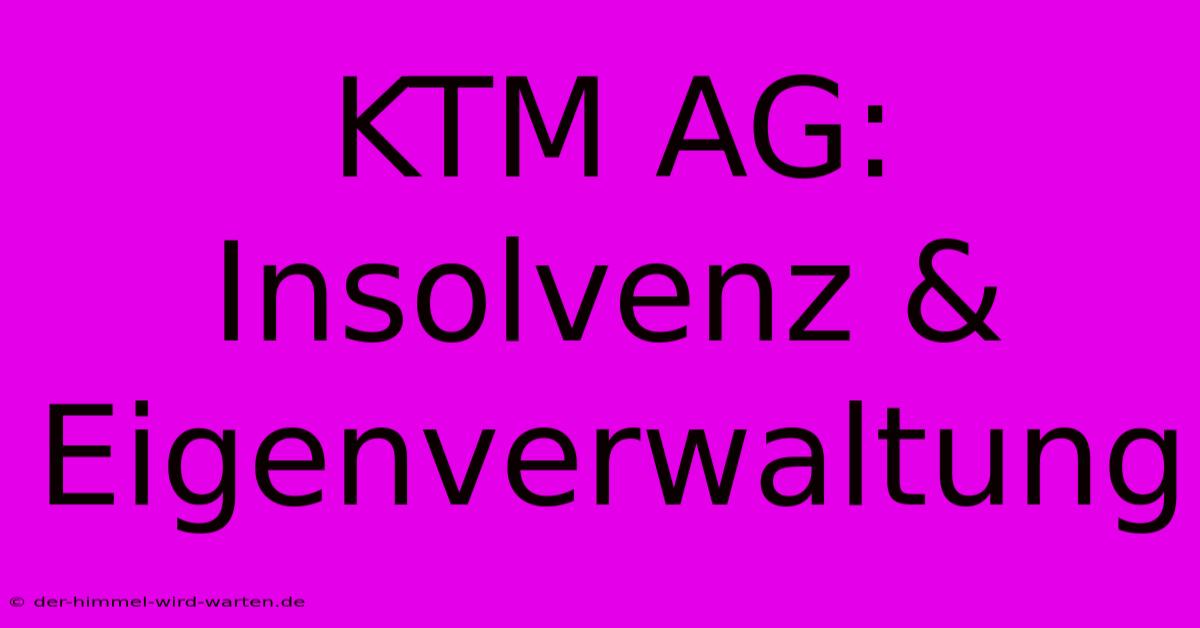KTM AG: Insolvenz & Eigenverwaltung

Discover more detailed and exciting information on our website. Click the link below to start your adventure: Visit Best Website KTM AG: Insolvenz & Eigenverwaltung. Don't miss out!
Table of Contents
KTM AG: Insolvenz & Eigenverwaltung – Ein Blick hinter die Kulissen
Hey Leute, let's talk about something serious that hit the motorcycle world hard: KTM AG's brush with insolvency and its subsequent self-administration (Eigenverwaltung). It was a wild ride, let me tell you. I remember when the news broke – total shock! I mean, KTM? The name synonymous with aggressive orange machines? In trouble? It felt surreal.
I’ll be honest, my initial reaction was panic. I immediately started thinking about the impact on the whole industry, on the riders, the mechanics, the whole shebang. I dove headfirst into researching the situation, trying to understand what went wrong. And believe me, there was a lot to unpack.
The Rollercoaster of KTM's Financial Troubles
The core problem, as I understood it after tons of reading (and let’s be frank, a few sleepless nights), wasn't a sudden crash. It was more of a slow burn, a buildup of issues that eventually became unsustainable. Think of it like this: you’re riding a KTM – amazing power, right? But if you don't manage your fuel properly, even the most powerful bike will eventually sputter and stall. That’s kind of what happened to KTM.
They had ambitious expansion plans. They were pushing into new markets, investing heavily in R&D (research and development), and trying to maintain a competitive edge. All great in theory, but the execution, well, that’s where things got tricky. Apparently, they underestimated some costs, faced unexpected supply chain issues (we all know how that goes, right?), and maybe got a little too aggressive with their growth strategy. There's also talk of some miscalculations in their financial projections – things didn't quite match up with reality.
Key Factors Contributing to the Crisis
- Over-expansion: Reaching for too much too quickly can be a recipe for disaster.
- Supply chain disruptions: Global events can really mess with the best-laid plans.
- Underestimation of costs: Sometimes, the numbers just don't add up.
- Aggressive growth strategy: A high-risk, high-reward approach that can backfire spectacularly.
Eigenverwaltung – A Gamble That Paid Off (Mostly)
Now, here's where things get really interesting. Instead of going for a full-blown insolvency process with external administrators calling the shots, KTM opted for Eigenverwaltung. This basically means they got to manage the restructuring themselves, under court supervision. This is a risky move – it's like performing your own open-heart surgery – but it allowed them to maintain control and potentially preserve more jobs.
It wasn't a smooth process. There were tough negotiations with creditors, painful cost-cutting measures, and a whole lot of uncertainty. But they managed to restructure their debt, secure additional financing, and ultimately avoid complete liquidation.
The success of Eigenverwaltung depends a lot on factors such as the willingness of creditors to cooperate and the ability of the management team to implement a credible restructuring plan, among other aspects.
What We Learned From KTM's Near-Death Experience
This whole situation taught me a valuable lesson: Even giants can stumble. Careful financial planning, realistic projections, and a flexible approach to market changes are crucial, even for a powerhouse like KTM.
Furthermore, choosing the right restructuring strategy can be vital in navigating a financial crisis. The decision to pursue Eigenverwaltung proved to be a pivotal one for KTM, allowing them to maintain operational control and a faster path to recovery.
The story of KTM's insolvency and Eigenverwaltung is a complex one, filled with twists and turns. It highlights the challenges faced by even the most successful companies and offers valuable lessons on financial management and crisis response for businesses of all sizes. And hey, it also reminds us that even the coolest motorcycles can have their engine problems!
Keywords: KTM AG, Insolvenz, Eigenverwaltung, Restrukturierung, Finanzkrise, Motorradindustrie, Supply Chain, Unternehmenskrise, Sanierung, Gläubiger, Kostenmanagement, Wachstum, Expansion, Finanzplanung.

Thank you for visiting our website wich cover about KTM AG: Insolvenz & Eigenverwaltung. We hope the information provided has been useful to you. Feel free to contact us if you have any questions or need further assistance. See you next time and dont miss to bookmark.
Featured Posts
-
Psg Sieg Fuer Bayern Leverkusen Siegt Hoch Leipzig Am Ende
Nov 27, 2024
-
Harris Misstritt Ruiniert Wahlchancen
Nov 27, 2024
-
Kabinettsstreit Republikanerin Im Visier
Nov 27, 2024
-
Schock Fuer Bayern Talente Verlieren
Nov 27, 2024
-
Alte Pinakothek Rachel Ruysch Retrospektive
Nov 27, 2024
